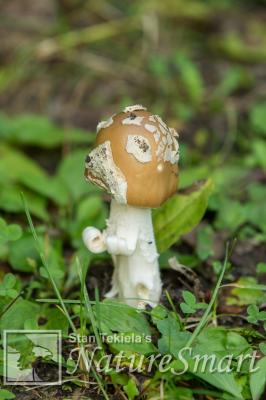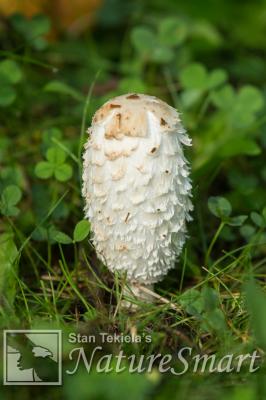View all of the titles in the
NatureSmart Bookstore


by Stan Tekiela
© NatureSmart
October 9, 2017
Late summer and early fall is the best time for mushrooms. For the past couple of weeks I've been out and about searching high and low for all sorts of mushrooms. I find peace in the simple act of walking in the woods without a specific purpose and being happy with whatever I find.
About 25 years ago I wrote a book about how to find wild edible mushrooms. The book highlighted 6 common edible mushrooms that didn't have poisonous look-a-likes. At the time it seemed like not many people were willing to spend the time to learn how to safely collect edible mushrooms. Now I am updating this book because it seems so many more people are interested in collecting edible mushrooms.
Finding and collecting edible mushrooms might seem like a daunting task considering that there is an estimated 5.1 million different kinds of fungi in the world. Compare that to about 10,000 species of birds and only 5,000 species of mammal. With over 5 million different kinds of fungi, no one can be an expert. It is just too much information for any one person to know it all.
First let's talk about what is a mushroom, or more technically called a fungi. I like to make a comparison between an apple tree and fungi. The apple tree and the fungi are the living parts. The tree grows above ground compared to the fungi that grows underground or inside a fallen log. When it comes time for the apple tree to reproduce, it grows apples with the seeds inside. The apple is a vehicle to transport the seeds (within) to another location to grown another tree. When a fungi wants to reproduce it does so by sending up or sending out mushrooms. The mushroom contains all of the spores (not seeds) for the fungi to reproduce. The spores blow away on the wind to grow another fungi. So the mushroom is just like the apple, only you can't see the tree part unless you dug it up.
Fungi are not plants. The cells which make up the two organism are fundamentally different. Plants are made up primarily of cellulose while fungi consist mostly of chitin (pronounced kitin). Chitin is also the primary component of the exoskeletons of insects and what your fingernails and hair are made of. It is more difficult to digest than cellulose.
Fungi play one of the most important roles in all our ecosystems. Fungi are found in terrestrial, marine, and freshwater environments all over the planet. In fact it is estimated that fungi grow in every square inch of soil everywhere. Fungi spores have been found in the air several miles high.
Fungi are on the front lines in the community of decomposers. In fact without fungi, every branch and tree that has fallen in the forest would still be laying on the ground if it weren't for the decomposing powers of the fungi. They take the large dead objects like tree trunks and start breaking them down to the point where bacterial and other organisms can take over. This is so important to recycle the nutrients locked up in the trees and return the nutrients back to the soil and thus making it available for new trees.
Finding edible mushrooms and avoiding the deadly ones is the real trick. I was reminded of this a couple days ago when photographing an edible Shaggy Mane (Coprinus comatus) mushroom on a grassy trail. Just 6 feet away was a deadly Amanita mushroom that looks ridiculously similar. If you weren't paying full attention you might easily think they were both the edible Shaggy and pick the deadly Amanita. The results would be disastrous.
By the way everyone who has ever eaten a deadly mushroom reported that they tasted great. Unlike what you see in the movies and TV, when you eat a deadly mushroom you don't suddenly drop over dead. In fact it is a long, drawn out process of many days and weeks. In fact the first symptoms don't show up until 48 to 72 hours (2 to 3 days) after you ate the mushroom. This is because most of these toxins will kill your liver and the first symptoms occur when your liver starts to fail.
The only treatment for this is a liver transplant. Something I would not recommend. So this year enjoy the mushrooms but there is an old saying that goes like this. There are old mushroom hunters and there are bold mushroom hunters but there are NO old and bold mushroom hunters. Until next time...
Stan Tekiela is an author / naturalist and wildlife photographer who travels the US to study and photograph wildlife. He can be followed on facebook.com and twitter.com. He can be contacted via his web page at www.naturesmart.com.
The nationally syndicated NatureSmart Column appears in over 25 cities spanning 7 states: Minnesota, Wisconsin, Michigan, Illinois, Ohio, New York and Pennsylvania. It is a bi-weekly column circulated to over 750,000 readers.
Wolves
Just the day before, a pack of wolves known as the Wapiti, had found a large bull bison that was weak and injured. Based on its size, this big boy was near the end of its lifespan and the winter weather was taking its toll. For a full day the wolves tried to approach the bison but when the bison...
Moose
It was one of those dark and cloudy winter days in Yellowstone National Park where the clouds are so heavy and low, you feel like you can reach up and touch the cloudy sky. A light wind helped to blow the falling snow with occasional gusts of wind causing swirls of fluffy white snow...
American Badger
It’s funny, I believe the average person knows more about the Honey Badger (Mellivora capensis), a critter of Africa and Southwest Asia than they do about the badger in our own backyard, the American Badger (Taxidea taxus). Social media has a lot to do with the Honey Badger phenomena and...
Backyard Bird Feeding
Winter bird feeding is one of the most common / popular hobbies in America. It is estimated that nearly 60 million Americans feed birds in their yards in winter or summer. That is about 40 percent of all American’s make backyard bird feeding part of their everyday activities. It’s...
View all of the titles in the
NatureSmart Bookstore
Check out Stan's latest photos at
NatureSmart Wildlife Images
Take a tour with Stan.
» More Info
Hear Stan on radio stations all across the Midwest.
» More Info

When he's out in the field, Stan relies on his Vortex Razor binoculars and Vortex Razor spotting scope to help find the subjects for his award winning wildlife photography.

For thirty years, professional wildlife photographer Stan Tekiela has counted on Hunt's Photo and Video to provide him with professional photography equipment.
From tripods to camera bodies and lenses, Hunt's has been Stan's place for everything that he needs. Personal service and prompt shipping means Stan can count on Hunt's to support his professional wildlife photography career.


Professional Wildlife Photographer Stan Tekiela always uses Feeder Fresh in his seed feeders to help keep the feeders and food dry, clean and mold free.
He also uses Feeder Fresh Nectar Defender in all of his hummingbird feeders. It safely keeps nectar fresh longer.